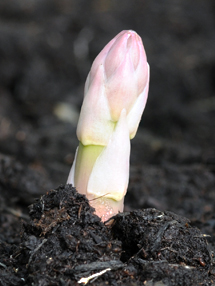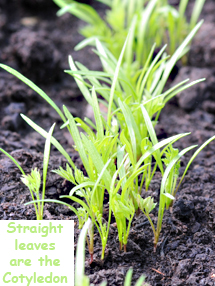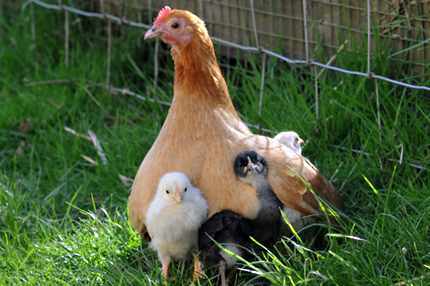Welcome to Relaxed Farming
- Alpacas
- Chickens
- Dairy Goats
- Ducks
- Geese
- Pigs
- Pygmy Goats
- Quail
- Rabbits
- Sheep
- Turkeys
- Polytunnel
- Photo Stories
- Video Stories
- Food
- Smallholding Map
- 2013
- 2014


- August
- September
- October
- November
- December
- January
- February
- March
- April
- May
- June
- July
- August


- 1
- 2
- 3
- 4
- 5
- 6
- 7
- 8
- 9
- 10
- 11
- 12
- 13
- 14
- 15
- 16
- 17
- 18
- 19
- 20
- 21
- 22
- 23
- 24
- 25
- 26
- 27
- 28
- 29
- 30
- 31
Monday, 14th April 2014
There was huge excitement this morning as when we were checking the polytunnel we spied the very first spear of asparagus. As you can see the curved shape of the top of the spear means it can push up through the soil quite easily and without damaging the rest of the plant. At the moment the spear is whitey/pink - it will however become green through a process known as photosynthesis. This is very complex process whereby a plant uses sunlight, carbon dioxide (from the air) and water (from the roots) to produce oxygen and glucose (a type of sugar). Within the plant is a substance called chlorophyll and this absorbs the sunlight so making the plant green. Photosynthesis is basically all about the plant making its own food (the sugars) so it can then grow (just like humans).
Amazingly when we checked later in the afternoon, two more spears were showing. We will let them grow to about 15cms and then cut them down to eat. The more we cut, the more will grow. This is because the plant wants to continue to survive so when a spear is cut, this stimulates more growth in the crown (body of the plant).
In the next photo you can see our young carrots which are all growing well. They are now starting to produce their feathery leaves. The very first leaves of the carrot plant are long and straight as you can clearly see in the plant above the label. These leaves are known as the cotyledon and are always the first to appear and, as in the case of the carrot, are often very different in shape. In some plants you don't actually see these as they stay below the ground. Another example of cotyledon leaves you do see are in beans (a plant you have probably grown in the classroom; again, the first leaves are very different...).
Finally, we had to show you just what a fabulous mum our broody bantam is continuing to be: she looks after her young chicks so well. This photo is rather comical with one black chick 'bottom in air' as he/she tries to crawl under mum's feathers and the other black chick looking rather wedged in just under her neck! Bless!


